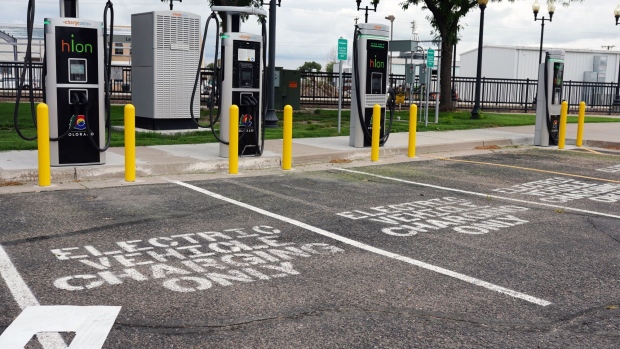Jan 31, 2024
More Than 1,000 New EV Stations Have Come Online in the US Since Summer
, Bloomberg News

(Bloomberg) -- The vastness of rural America has long been a challenge for electric vehicles, but the country’s electron deserts are disappearing quickly.
US drivers welcomed almost 1,100 new public, fast-charging stations in the second half of 2023, a 16% increase, according to a Bloomberg Green analysis of federal data. Put another way: There is now one quick-turn EV station for every 16 or so gas stations in the country (though many convenience stores now sell both kinds of go-juice). “This is just a very exciting moment,” said Katherine Garcia, director of Clean Transportation for All at the Sierra Club. “And I think we’re going to continue seeing this growth trajectory.”
The rash of new chargers isn’t limited to hotbeds of EV adoption. Idaho, for example, switched on 12 new fast-charging stations (also known as “DC fast chargers”) between July and December. The Deep South is plugging in quickly, too. Collectively, Alabama, Arkansas, Mississippi and Tennessee welcomed 56 new fast-charging stations in the second half of 2023, an infrastructure increase of one-third. Florida and Texas are now the No. 2 and No. 3 states for charging spots, respectively.
“It’s been kind of a worn-out talking point from some of the opponents of EVs, that the infrastructure’s just not ready,” said Albert Gore, executive director of the Zero Emission Transportation Association. “But that overlooks the fact that there’s phenomenal growth taking place.”
Gore said many drivers don’t realize how many charging stations are nearby simply because the sites are not as noticeable as gas stations or as central to the auto ownership experience; those who charge an EV at home, for example, may seldom seek a public cord.
The pace of new chargers isn’t slowing anytime soon. The vast majority of chargers added in the US last year were bets by for-profit companies on the future of battery-powered driving. This year, states will start deploying $5 billion in federal money geared at ensuring the charger network is so dense that adopting an EV is a no-brainer. The goal, as laid out by the National Electric Vehicle Infrastructure program, is to have a public, fast-charging station at least every 50 miles along the nation’s major travel corridors. Seven states, including Alaska, Hawaii and Kentucky, have already begun doling out those funds, and the first of the federally backed stations powered up in December just west of Columbus, Ohio.
Read More: EV Charging Networks Should Be Regulated, California Energy Official Says
“It will be a constant drumbeat of new stations,” Gore said. “We’re really confident that charging infrastructure is not going to be a constraint on EV deployment in the United States.”
Charging options will also increase this year as Tesla Inc. begins to open its network of Superchargers to vehicles made by other automakers. The company is responsible for slightly more than one-quarter of all US fast-charging stations, though its sites tend to be larger, so roughly two-thirds of all cords in the country are geared for Tesla ports.
Samantha Houston, senior vehicles analyst at the Union of Concerned Scientists, said the wave of new chargers will help buttress demand for EVs. Meanwhile, the economics of operating a charging station are improving thanks to a more dense electric fleet and pricing that flexes based on electricity demand on the grid at-large.
“There's all of these things that are creating a reinforcing virtuous cycle to accelerate the transition,” she said, “which is good because we need to make as much progress as we can as soon as possible, both for the climate and local air quality.”
Read Next: Why So Many Electric Car Chargers in America Don't Work
©2024 Bloomberg L.P.


